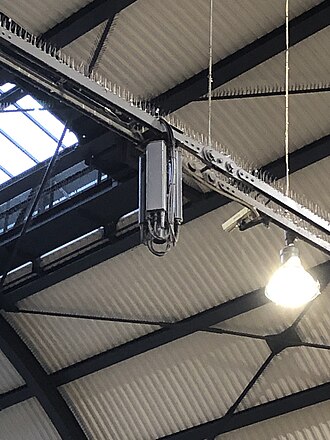Cellular network






Cellular network refers to a type of telecommunications network where the last mile is wireless. The network is distributed over land areas called "cells", each served by at least one fixed-location transceiver, known as a cell site or base station. When joined together, these cells provide radio coverage over larger geographic areas. This enables a large number of portable transceivers, such as mobile phones, tablet computers, and laptop computers with mobile broadband modems to communicate with the network and with each other. Cellular networks offer a number of advantages such as increased capacity, reduced power usage, larger coverage area, and reduced interference from other signals.
History[edit]
The concept of a cellular network was developed in the 1940s and 1950s by engineers at Bell Labs and later was implemented in the first commercial mobile phone network, launched in Japan by NTT in 1979. The development of cellular networks is divided into generations, beginning with the 1G (First Generation) networks that were analog and moving through 2G, 3G, 4G, and now 5G networks, which are digital and offer increased speed, capacity, and services.
Technology[edit]
Cellular networks are comprised of several key components including cell sites, the Mobile Switching Center (MSC), the Public Switched Telephone Network (PSTN), and a variety of communication protocols that manage the flow of data and voice between mobile devices and the network.
Cell Sites[edit]
A cell site is composed of a tower and a small building containing the radio equipment. Each cell site covers a specific area and can handle a certain number of simultaneous conversations, depending on the technology and the frequency of the radio waves.
Mobile Switching Center[edit]
The MSC is the central component of a cellular network. It connects calls by setting up the path for each call based on the destination. The MSC also manages mobile services such as registration, authentication, location updating, handovers, and call routing.
Communication Protocols[edit]
Cellular networks use various protocols to manage the signaling and data transfer. These include the Global System for Mobile Communications (GSM), General Packet Radio Service (GPRS), Enhanced Data Rates for GSM Evolution (EDGE), Universal Mobile Telecommunications System (UMTS), and Long-Term Evolution (LTE).
Generations of Cellular Networks[edit]
Each generation of cellular networks has been marked by significant advancements in technology.
- 1G - The first generation of cellular networks, introduced in the late 1970s and early 1980s, was analog and supported only voice calls.
- 2G - Introduced in the 1990s, 2G networks were digital and introduced data services such as SMS and MMS.
- 3G - Launched in the early 2000s, 3G networks provided higher data rates, enabling mobile internet access and video calls.
- 4G - The fourth generation, introduced in the late 2000s, offered even higher data rates, supporting HD TV, video conferencing, and mobile gaming.
- 5G - The latest generation, being rolled out since 2019, promises significantly higher data rates, reduced latency, energy saving, cost reduction, higher system capacity, and massive device connectivity.
Challenges and Future Directions[edit]
While cellular networks have revolutionized telecommunications, they face challenges such as spectrum scarcity, privacy and security concerns, and the need for infrastructure to support increasing data traffic. Future directions include the development of more advanced 5G technologies, integration with satellite networks, and the exploration of new spectrum bands for cellular communications.
Ad. Transform your life with W8MD's Budget GLP-1 injections from $75


W8MD offers a medical weight loss program to lose weight in Philadelphia. Our physician-supervised medical weight loss provides:
- Weight loss injections in NYC (generic and brand names):
- Zepbound / Mounjaro, Wegovy / Ozempic, Saxenda
- Most insurances accepted or discounted self-pay rates. We will obtain insurance prior authorizations if needed.
- Generic GLP1 weight loss injections from $75 for the starting dose.
- Also offer prescription weight loss medications including Phentermine, Qsymia, Diethylpropion, Contrave etc.
NYC weight loss doctor appointmentsNYC weight loss doctor appointments
Start your NYC weight loss journey today at our NYC medical weight loss and Philadelphia medical weight loss clinics.
- Call 718-946-5500 to lose weight in NYC or for medical weight loss in Philadelphia 215-676-2334.
- Tags:NYC medical weight loss, Philadelphia lose weight Zepbound NYC, Budget GLP1 weight loss injections, Wegovy Philadelphia, Wegovy NYC, Philadelphia medical weight loss, Brookly weight loss and Wegovy NYC
|
WikiMD's Wellness Encyclopedia |
| Let Food Be Thy Medicine Medicine Thy Food - Hippocrates |
Medical Disclaimer: WikiMD is not a substitute for professional medical advice. The information on WikiMD is provided as an information resource only, may be incorrect, outdated or misleading, and is not to be used or relied on for any diagnostic or treatment purposes. Please consult your health care provider before making any healthcare decisions or for guidance about a specific medical condition. WikiMD expressly disclaims responsibility, and shall have no liability, for any damages, loss, injury, or liability whatsoever suffered as a result of your reliance on the information contained in this site. By visiting this site you agree to the foregoing terms and conditions, which may from time to time be changed or supplemented by WikiMD. If you do not agree to the foregoing terms and conditions, you should not enter or use this site. See full disclaimer.
Credits:Most images are courtesy of Wikimedia commons, and templates, categories Wikipedia, licensed under CC BY SA or similar.
Translate this page: - East Asian
中文,
日本,
한국어,
South Asian
हिन्दी,
தமிழ்,
తెలుగు,
Urdu,
ಕನ್ನಡ,
Southeast Asian
Indonesian,
Vietnamese,
Thai,
မြန်မာဘာသာ,
বাংলা
European
español,
Deutsch,
français,
Greek,
português do Brasil,
polski,
română,
русский,
Nederlands,
norsk,
svenska,
suomi,
Italian
Middle Eastern & African
عربى,
Turkish,
Persian,
Hebrew,
Afrikaans,
isiZulu,
Kiswahili,
Other
Bulgarian,
Hungarian,
Czech,
Swedish,
മലയാളം,
मराठी,
ਪੰਜਾਬੀ,
ગુજરાતી,
Portuguese,
Ukrainian
